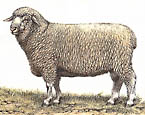|
Red
Sheep (Domestic)
(Ovis aries domestica) #61-693 |
||||
|
MSU Atlas of the Sheep Brain
|
Physical
characteristics and distribution
|
|
Red Sheep (Domestic) are gregarious, sometimes gathering in herds of over 100 individuals. In some species, mature males stay apart from the females and the young for most of the year. In both the old and New World, the rut occurs mainly in the autumn and early winter, and births take place in the spring. Chromosomal and archeological evidence indicates that the Domestic sheep is descended from a mouflon-like animal and that domestication occurred about 10,000 - 11,000 years ago in the eastern Mediterranean region. No Wild sheep has a woolly coat comparable to that of Domestic sheep. There are now more than 800 breeds of Domestic sheep. Domestic sheep have adversely affected its wild relatives in many areas by competing with them for forage and spreading disease. Wild species have also declined through agricultural encroachment, other human habitat modifications, as well as by indiscriminate hunting. Farmers develop wool breeds for superior wool quantity. Breeders of dual purpose wool class sheep concentrate on fast growth, multiple births, ease of lambing and hardiness. Domestic sheep (Ovis aries) exist worldwide in association with humans. Wild sheep are usually found in upland areas. Red Sheep or Mouflin are found in Armenia, S Azerbaijan, N Iraq, W Iran, and S and E turkey; transported populations (Mouflon) on Corsica and Sardinia, introduced from there to Europe, Ukraine (Crimea), USA (incl. Hawaiian Isls), Chile, Kerguelen Isls, and Tenerife (Canary Isls); and on Cyprus. They are domesticated worldwide; feral populations on St. Kilda and other small islands off the British Isles; improved domestic stock feral in Norway, Sweden, USA, islands off coasts of United Kingdom and New Zealand, Kerguelen Isls, and probably other oceanic islands. |
|
Description
of the brain
|
|
Animal
source and preparation
|
|
All
specimens collected followed the same preparation
and histological procedure.
|
Other Related Resources (websites and publications)
List of Specimens | Explore Collections | Brain Sections | Brain Evolution | Brain Development | Brain Circuitry | Brain Functions | Location and Use | Related Web Sites | Contact Us | Search MSU Database | Personnel | Home


